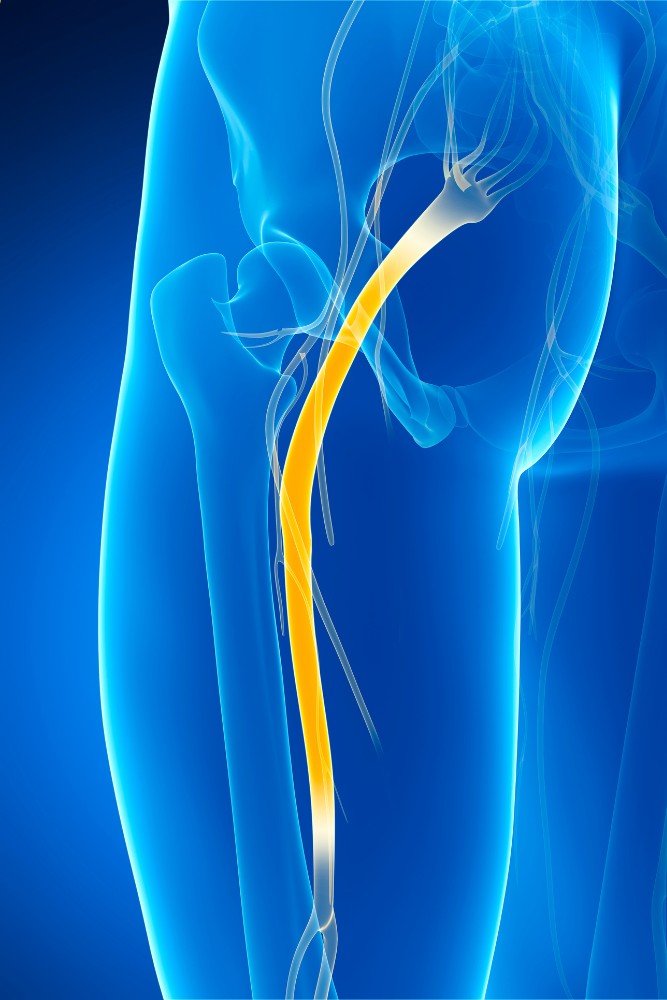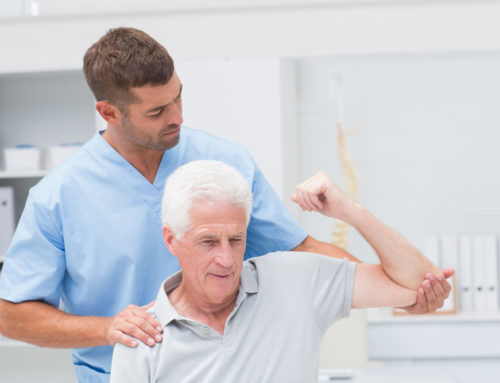The human body has two sciatic nerves, each extending from the spinal cord to the heel of one foot. Due to the length of these nerves, they are susceptible to damage or trauma. In fact, sciatic nerve pain in the lower back, hips, buttocks, and legs has three main causes.
Though treating the underlying cause is vital, physical therapy is often required to reduce your symptoms. Therapy includes exercises, stretches, and guided manual techniques to strengthen muscles, increase range of motion, and relieve pain. Knowing the causes of sciatic pain improves treatment and prevents further issues.
Sciatic Nerve Pain: 3 Reasons
As the human body’s longest nerve, the sciatic nerve interacts with most muscles between the lower back and the feet. When the muscles, skin, or other tissues nearby are pinched or injured, these nerves are often affected. The following sections discuss three common causes of sciatic pain.
1. Herniated disc
The spine consists of small bones called vertebrae. These pieces are separated by discs that absorb shock and prevent the vertebrae from rubbing together. When one of these discs is damaged or slips out of place, a hernia occurs.
Herniated discs may affect any part of the spine but are most common in the lower back. When this occurs, the disc frequently puts pressure on one side of the sciatic nerve.
Pain is often the first indication of sciatica from a herniated disc. It may be sharp, similar to an electric shock, and worsen when upright or moving. Burning, tingling, and numbness are also possible symptoms, frequently located in the legs, but occasionally in the lower back.

2. Tight muscle
Tight muscles are another possible cause of sciatic nerve pain. The piriformis muscle is located in the buttocks area, stretching from the lower back to the top of the femur. The sciatic nerve is directly beneath this muscle.
According to experts, several possible issues could damage or irritate the piriformis muscle. These include overuse, lifting heavy objects, falls, accidents, or sitting too long. The injured muscle spasms, putting pressure on the sciatic nerve beneath it.
Poor posture and prolonged sitting with improper back support can also gradually tighten muscles around the hips and spine, indirectly irritating the sciatic nerve. Desk workers and long-distance drivers often develop this condition unknowingly, which is why ergonomic chairs, posture awareness, and regular movement breaks are strongly recommended.
The most common symptom of piriformis syndrome and the resulting sciatica is pain. You may also experience tenderness, tingling, or numbness affecting the lower back, buttocks, and legs. These symptoms often worsen when sitting or during activity.
3. Nerve hypersensitivity
Increased nerve sensitivity may cause sciatic pain in some individuals, resulting from several possible issues. For instance, hyperesthesia causes sensitivity to touch, often resulting from nerve dysfunction or injury 5. Slight pressure on the sciatic nerve could cause high levels of discomfort, even without significant damage to the area.
Hypersensitivity could also result from lumbar spinal stenosis, which occurs when the spinal canal narrows. The condition frequently affects the lower back, putting pressure on the spinal cord. This pressure extends to the surrounding nerves, including the sciatic.
Thickened ligaments, bone spurs, and spinal injuries also put excess pressure on the spinal cord and nearby nerves. Pain, tingling, numbness, and issues with balance or walking are symptoms to watch for.
Understanding the root causes of sciatic nerve pain is crucial for effective treatment and long-term relief. Whether the issue stems from a herniated disc, tight muscles, or increased nerve sensitivity, targeted therapies and lifestyle changes can significantly improve symptoms.
Early intervention, proper diagnosis, and consistent physical care are key to preventing chronic discomfort and improving overall mobility. If you experience persistent sciatic pain, consult a healthcare provider to determine the best course of action.
Resources:
- NCBI, Nov. 16, 2023, Anatomy, Sciatic Nerve
https://www.ncbi.nlm.nih.gov/books/NBK482431/ - NCBI, Jan. 16, Disc Herniation
https://www.ncbi.nlm.nih.gov/books/NBK441822/ - AANS, March 20, 2024, Herniated Disc
https://www.aans.org/patients/conditions-treatments/herniated-disc/#:~:text=Lumbar%20spine%20(lower%20back)%3A,and%20sometimes%20into%20the%20foot - MedlinePlus, Piriformis syndrome
https://medlineplus.gov/ency/patientinstructions/000776.htm - Cleveland Clinic, Hyperesthesia
https://my.clevelandclinic.org/health/symptoms/hyperesthesia - Johns Hopkins Medicine, Lumbar Spinal Stenosis
https://www.hopkinsmedicine.org/health/conditions-and-diseases/lumbar-spinal-stenosis - Mayo Clinic, Spinal stenosis
https://www.mayoclinic.org/diseases-conditions/spinal-stenosis/symptoms-causes/syc-20352961
This content comprises informative and educational resources only and can not be considered as a substitute for professional health or medical guidance. Reliance on any information provided in this article is solely at your own risk. If you have any inquiries or apprehensions about your medical condition or health goals, talk with a licensed physician or healthcare provider.






Leave A Comment